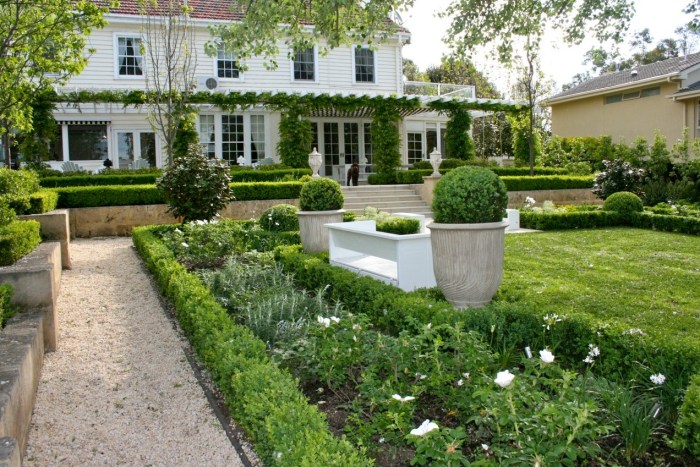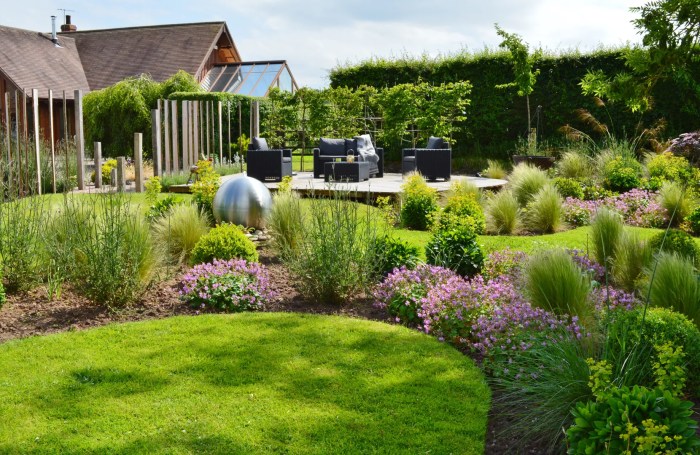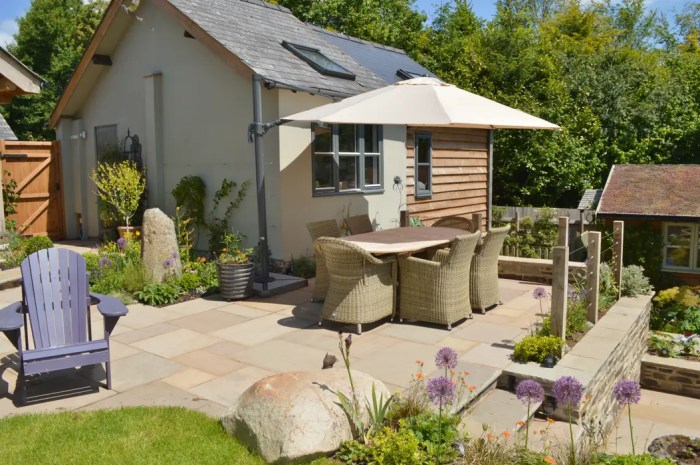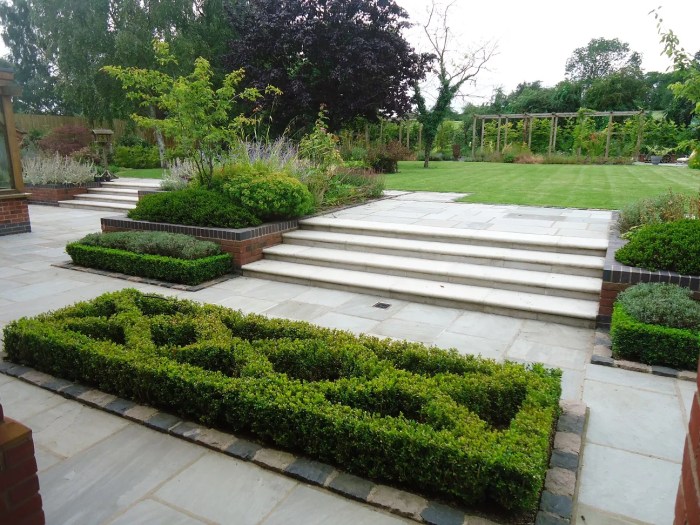The allure of a classic garden lies in its timeless elegance, a harmonious blend of nature’s artistry and human design. From the symmetrical precision of a formal French garden to the rambling charm of a cottage garden, the principles of classic design offer a wealth of possibilities. Understanding the interplay of plant selection, hardscaping elements, and spatial arrangement is key to crafting a space that evokes tranquility and beauty.
This exploration delves into the scientific underpinnings of successful garden design, combining horticultural knowledge with aesthetic considerations to guide you in creating your own classic sanctuary.
Successful classic garden design hinges on several key factors. Firstly, meticulous planning is paramount. This involves analyzing sunlight exposure, soil composition (pH levels, drainage), and water availability—all crucial factors influencing plant health and longevity. Secondly, the careful selection and placement of plants are vital, considering bloom times, colors, textures, and heights to create visual harmony. Thirdly, the integration of hardscaping elements—pathways, walls, and water features—adds structure and enhances the overall aesthetic appeal.
Finally, ongoing maintenance, including pruning, weeding, and pest control, ensures the garden’s continued vibrancy.
Planning Your Classic Garden
Designing a classic garden involves careful planning to achieve a harmonious and aesthetically pleasing space. This requires understanding the principles of garden design, selecting appropriate plants, and considering the environmental conditions of your site. A successful classic garden is a testament to thoughtful planning and execution, resulting in a beautiful and functional outdoor area that can be enjoyed for years to come.
Classic Garden Layouts: Symmetry and Balance
Classic garden designs often emphasize symmetry and balance, creating a sense of order and tranquility. Formal gardens, for instance, utilize geometric shapes, precisely clipped hedges, and symmetrical planting schemes. Think of the iconic French parterre gardens at Versailles, with their intricate patterns of flowers and meticulously manicured lawns. In contrast, informal gardens embrace a more natural, flowing aesthetic, although balance and harmony are still key elements.
Cottage gardens, characterized by their abundance of flowering plants and rambling growth, achieve balance through a carefully curated mix of textures, heights, and colors. The key is to establish a focal point – perhaps a fountain, statue, or architectural feature – and arrange plants around it in a balanced, visually appealing manner. Careful consideration of sightlines and pathways is crucial in creating a harmonious flow throughout the garden.
Plant Selection for a Classic Garden
The choice of plants is paramount in achieving the desired aesthetic of a classic garden. The following table illustrates a selection of plants suitable for such a setting, categorized by bloom time, color, and plant type. Plant selection should also account for the specific needs of each species, as detailed in the next section.
| Plant Name | Bloom Time | Color | Plant Type |
|---|---|---|---|
| Lavender (Lavandula angustifolia) | Summer | Purple | Herb/Shrub |
| Roses (Rosa spp.) | Spring/Summer/Autumn (depending on variety) | Various (red, pink, white, yellow, etc.) | Shrub |
| Peonies (Paeonia spp.) | Late Spring | Various (pink, red, white) | Herbaceous Perennial |
| Hydrangeas (Hydrangea macrophylla) | Summer | Various (pink, blue, white) | Shrub |
| Daylilies (Hemerocallis spp.) | Summer | Various (yellow, orange, red, pink, etc.) | Herbaceous Perennial |
| Salvia (Salvia spp.) | Summer/Autumn | Various (blue, purple, red) | Herbaceous Perennial |
Sunlight, Soil, and Drainage: Essential Considerations for Plant Placement
Successful plant growth depends heavily on the provision of suitable environmental conditions. Sunlight exposure dictates which plants will thrive in a given area. Sun-loving plants, such as lavender and roses, require at least six hours of direct sunlight daily, while shade-tolerant plants, like hostas, prefer dappled shade or partial sun. Soil type significantly impacts plant health. Well-drained soil is crucial for most plants to prevent root rot.
Clay soils, for example, tend to retain water, potentially leading to waterlogged conditions, while sandy soils drain quickly, requiring more frequent watering. A soil test can determine the pH level and nutrient content, informing decisions about soil amendments (such as compost or fertilizer) to optimize growing conditions. Proper drainage is essential to prevent waterlogging, which can suffocate plant roots.
Raised beds or the addition of organic matter can improve drainage in poorly draining soils. Understanding these factors is crucial for selecting appropriate plant species and ensuring their successful establishment and growth within the garden’s context.
Choosing Classic Garden Elements

The selection of appropriate hardscaping and ornamentation is crucial in establishing the atmosphere of a classic garden. These elements provide structure, delineate space, and contribute significantly to the overall aesthetic, guiding the eye and enhancing the beauty of the planting scheme. Careful consideration of materials, placement, and scale ensures harmony and visual interest within the garden design.
Hardscaping Elements in Classic Garden Design
Pathways, walls, and fountains are essential hardscaping elements that define the structure and flow of a classic garden. The choice of materials significantly impacts the overall aesthetic. For instance, a meandering path crafted from natural stone, such as flagstone or limestone, evokes a sense of age and rustic charm, complementing a naturalistic planting style. In contrast, precisely laid brick pathways create a more formal and structured feel, suitable for a geometric garden design.
Walls, whether constructed from brick, stone, or even rendered concrete, provide vertical interest and can be used to create secluded areas or define boundaries. The choice of material should complement the surrounding architecture and planting. Fountains, often incorporating classical sculptures or architectural details, introduce a dynamic element, adding the soothing sound of water and visual focal points.
Materials like aged stone or bronze create a timeless elegance.
Classic Garden Ornaments and Their Placement
The strategic placement of garden ornaments significantly enhances the visual appeal of a classic garden. These elements, carefully chosen and positioned, add layers of interest and contribute to the overall narrative of the space. Over-crowding should be avoided; instead, focus on strategically placing key pieces to maximize their impact.
- Statues: Classical statues, often depicting mythological figures or gods, add a sense of history and grandeur. They are best positioned near focal points, such as the end of a vista or at the center of a circular planting bed. Materials like marble or aged stone enhance the sense of timelessness. A large statue, for instance, might be positioned centrally to command attention, while smaller ones might be nestled amongst shrubs to create a sense of discovery.
- Birdbaths: These functional ornaments attract birds, adding life and movement to the garden. A simple, classical design in stone or cast iron complements the overall aesthetic. Placement near a water feature or in a sunny, sheltered spot encourages bird activity.
- Sundials: Sundials, often crafted from stone or metal, introduce a sense of history and artistry, reminding us of the passage of time. Their placement should be in a sunny location, preferably on a level surface, allowing for accurate timekeeping. A sundial positioned on a pedestal, for example, can serve as a focal point within a formal parterre.
Design of a Small Classic Garden Path Section
This section details the design of a 3-meter long segment of a classic garden path. The path will be 1 meter wide, constructed from reclaimed Yorkstone paving slabs. These slabs, ranging in size from 30cm x 30cm to 45cm x 45cm, will be laid in a slightly irregular pattern, mimicking a naturally occurring pathway. The gaps between the slabs will be filled with a fine, light-grey gravel to create a permeable surface and allow for drainage.
The overall aesthetic will be one of understated elegance, allowing the planting to take center stage. The irregular laying of the slabs, along with the gravel infill, will provide a natural, less formal look, contrasting subtly with the formality that may exist in other parts of the garden. This section of path will gently curve, creating a visually interesting and welcoming approach to a seating area or garden feature.
Plant Selection and Arrangement

Creating a classic garden requires careful consideration of plant selection and arrangement to achieve a harmonious and visually appealing design. The principles of balance, proportion, and repetition are crucial, drawing inspiration from historical garden styles while adapting to modern horticultural practices and available plant material. Successful plant combinations require understanding plant needs, growth habits, and aesthetic qualities.
A well-planned planting scheme considers not only the visual impact but also the long-term health and sustainability of the garden. This involves selecting plants suited to the local climate, soil conditions, and light levels, minimizing the need for excessive watering or fertilization. Understanding plant maturity sizes is essential to prevent overcrowding and ensure proper spacing for air circulation and sunlight penetration, reducing the risk of disease and pest infestations.
Designing a Mixed Border
A classic garden border often incorporates a mix of shrubs, perennials, and annuals to provide continuous bloom throughout the growing season. This layered approach creates visual interest and depth. The following example Artikels a planting plan for a 10-foot-wide border, assuming average soil and sunlight conditions. Plant spacing should be adjusted based on the mature size of each plant.
Starting at the back, we might place taller shrubs such as Potentilla fruticosa (shrubby cinquefoil), reaching 3-4 feet tall and wide, spaced 3-4 feet apart. Mid-level perennials, such as Delphinium (delphiniums) growing to 3-4 feet, could be placed in front, with a spacing of 18-24 inches. Lower-growing perennials like Geranium (cranesbill), reaching 1-2 feet, could fill the space in front of the delphiniums, spaced 12-18 inches apart.
Finally, annuals such as Petunia or Lobelia, reaching 6-12 inches, could be planted at the very front, spaced 6-12 inches apart. This layered approach creates a visually appealing, multi-textured, and colorful border.
Hedging in Classic Garden Styles
Hedging plays a significant role in defining spaces and creating structure within classic garden designs. Different styles utilize varying plant choices and pruning techniques.
Formal gardens, such as those found in French or Italian styles, often feature clipped hedges of Buxus sempervirens (boxwood) or Taxus baccata (yew). These plants tolerate regular, hard pruning, creating clean lines and geometric shapes. Pruning is typically done twice a year, once in late spring and again in late summer, removing approximately one-third of new growth. This maintains the desired shape and density.
In contrast, informal or cottage gardens might utilize less formally pruned hedges, such as Ligustrum (privet) or Carpinus betulus (hornbeam), allowing for a more natural, flowing appearance. Pruning is less frequent and less severe, focusing on maintaining overall shape and removing dead or crossing branches.
Creating a Textured and Colorful Flower Bed
A visually appealing flower bed relies on the strategic combination of textures and colors. This requires careful selection of plants with varying leaf shapes, sizes, and colors, as well as flowers of different forms and hues. The following table illustrates an example of a flower bed design emphasizing texture and color contrast.
| Plant Type | Color | Texture | Height (inches) |
|---|---|---|---|
| Salvia (Salvia) | Deep Blue/Purple | Spiky | 24-36 |
| Heuchera (Coral Bells) | Burgundy/Silver | Textured, Ruffled | 12-18 |
| Sedum (Stonecrop) | Pink/Green | Succulent, fleshy | 12-18 |
| Verbena bonariensis (Purpletop Vervain) | Lavender | Delicate, airy | 36-48 |
Maintaining a Classic Garden
A classic garden, with its emphasis on structure, symmetry, and carefully chosen plantings, requires diligent maintenance to retain its beauty and health. Neglect can quickly lead to a decline in the overall aesthetic and the well-being of the plants themselves. A proactive and informed approach to garden care is crucial for preserving the timeless elegance of this style.
Regular attention throughout the year ensures a thriving and visually stunning garden.
Seasonal Maintenance Schedule
A well-structured maintenance schedule, tailored to the specific needs of the plants and the prevailing climate, is essential for a classic garden’s longevity. Different seasons present unique challenges and opportunities for care. The following schedule provides a framework for maintaining optimal garden health.
- Spring: Begin by clearing away winter debris, pruning perennials and shrubs to encourage new growth, and applying a balanced fertilizer to promote healthy foliage. Weed before they become established, and begin regular watering as needed, particularly during dry spells. Inspect plants for signs of early pests or diseases.
- Summer: Regular watering is critical during summer’s heat. Deadhead spent blooms to encourage further flowering and prevent seed production, which can drain plant energy. Monitor for pests and diseases, taking prompt action if problems arise. Mulch around plants to retain soil moisture and suppress weeds.
- Autumn: As temperatures cool, reduce watering frequency. Prune back summer-flowering perennials and prepare for winter by cleaning up fallen leaves and debris. Apply a layer of mulch to protect plant roots from frost. Divide overcrowded perennials to maintain vigor.
- Winter: While activity is reduced, winter presents opportunities for planning and preparation. Protect tender plants from harsh weather conditions. Order seeds or bulbs for the upcoming season. Inspect structures such as trellises and fences for damage.
Common Garden Pests and Diseases
Classic gardens, while aesthetically pleasing, are not immune to the challenges posed by pests and diseases. Early detection and appropriate management strategies are key to preventing widespread damage.
- Aphids: These small, sap-sucking insects can infest a wide range of plants, causing stunted growth and leaf distortion. Control methods include insecticidal soap, neem oil, or introducing beneficial insects like ladybugs.
- Powdery Mildew: A fungal disease that appears as a white powdery coating on leaves, powdery mildew thrives in humid conditions. Prevention involves ensuring good air circulation and avoiding overhead watering. Treatment options include fungicides containing sulfur or potassium bicarbonate.
- Rose Black Spot: This fungal disease affects roses, causing black spots on leaves and defoliation. Maintaining good air circulation, removing infected leaves, and applying fungicides are effective control measures. Choosing disease-resistant rose varieties is also crucial.
- Slugs and Snails: These mollusks can cause significant damage to foliage, particularly during damp weather. Control methods include handpicking, beer traps, or using commercially available slug pellets.
Deadheading: Promoting Health and Bloom
Deadheading, the removal of spent flowers, is a vital practice in maintaining the health and aesthetic appeal of a classic garden. By removing faded blooms, the plant’s energy is redirected towards producing new flowers rather than developing seeds. This results in prolonged flowering periods and a more vibrant display. Examples of plants that benefit greatly from deadheading include roses, dahlias, salvia, and coneflowers.
Regular deadheading ensures a continuous show of blooms throughout the growing season.
Illustrative Examples of Classic Garden Designs

Classic garden design principles, emphasizing symmetry, balance, and the harmonious integration of plants and structures, have inspired countless beautiful and functional outdoor spaces. The following examples illustrate the application of these principles in three distinct garden styles: the rose garden, the herb garden, and the knot garden. Each exemplifies a different approach to achieving a classic aesthetic, demonstrating the versatility of traditional design.
A Classic Rose Garden Design
The quintessential classic rose garden evokes a sense of romance and tranquility. Successful design relies on careful rose selection, thoughtful arrangement, and the incorporation of supportive architectural elements. A palette of colors, from deep crimson to soft pastel shades, can be chosen to create a visually stunning effect, playing with contrasting or complementary hues. The arrangement often employs a formal structure, perhaps with roses planted in geometric patterns or along meticulously maintained pathways.Imagine a rectangular rose garden, bordered by neatly clipped boxwood hedges.
Within this framework, several varieties of roses are planted in distinct beds. Climbing roses, such as ‘Zephirine Drouhin’ (a thornless variety with a deep pink bloom), are trained on elegant wrought-iron arches that span the pathways, creating fragrant, arched gateways. Bush roses, including the intensely fragrant ‘Gertrude Jekyll’ (a classic English rose with large, cupped blooms in a rich pink), are planted in carefully arranged rows, their colors and heights carefully considered for a balanced visual impact.
The inclusion of shorter, ground-covering roses, like ‘The Fairy’ (a miniature rose with clusters of tiny, intensely pink flowers), provides a textural contrast and fills any gaps between the taller varieties. A central fountain, made of weathered stone, adds a focal point and a calming element to the scene, its gentle splashing sounds enhancing the peaceful atmosphere.
A Classic Herb Garden Design
The classic herb garden is a blend of practicality and beauty, a space where culinary and medicinal plants are cultivated in a visually appealing manner. The selection of herbs is crucial, both for their culinary and aesthetic qualities. Consider a mix of herbs with varied heights, colors, and textures to create visual interest. A design that uses raised beds or a series of terracotta pots can add visual appeal and improve drainage, which is essential for many herbs.
The arrangement often incorporates a functional aspect, grouping herbs with similar needs together, or organizing them by their culinary use (e.g., a section for baking herbs, another for savory herbs).Envision a sun-drenched herb garden, framed by a low, dry-stone wall. Within, neatly organized raised beds are planted with a diverse collection of herbs. Rosemary, with its aromatic evergreen foliage, forms a structural backbone, its upright stems providing a backdrop for lower-growing herbs.
Lavender, known for its calming fragrance and silvery-grey leaves, is strategically placed to add a textural contrast. Thyme, with its tiny, fragrant leaves, spills over the edges of the beds, creating a soft, cascading effect. Chives, with their delicate, grassy foliage, are planted amongst other herbs, their vibrant green adding a refreshing touch. Each herb’s specific needs are considered – sunny spots for basil, shadier areas for mint.
A small, rustic wooden bench invites visitors to sit and enjoy the calming fragrance of the herbs and the overall tranquility of the space. The herbs are labeled clearly with small slate markers, enhancing the educational aspect of the garden.
A Classic Knot Garden Design
The knot garden is a masterpiece of geometric design, a testament to the artistry of formal gardening. These gardens use low-growing plants to create intricate, symmetrical patterns, often incorporating variations of geometric shapes such as circles, squares, and diamonds. The selection of plants is critical, with varieties chosen for their ability to maintain a neat, compact form and for their contrasting foliage colors.
The effect is one of elegant precision, a testament to careful planning and meticulous maintenance. Plants used in knot gardens must be relatively low-growing and densely packed to maintain the sharpness of the pattern.Picture a perfectly square knot garden, its edges precisely defined by clipped boxwood hedges. Within this framework, a complex pattern of interweaving lines is created using low-growing plants.
The design might feature a central diamond shape, surrounded by smaller, repeating patterns. The plants used are carefully selected to provide contrasting colors and textures. Dark green boxwood is used to define the main lines of the design, while silvery-leaved Artemisia provides a striking contrast. Small patches of yellow-flowered alyssum are incorporated strategically to add pops of bright color, breaking up the dark and silvery tones.
The overall effect is one of stunning visual intricacy, a carefully orchestrated display of horticultural precision. The intricate patterns create an illusion of depth and movement, making the knot garden a captivating and engaging space.
Closure

Designing a classic garden is a journey of horticultural exploration and artistic expression. By understanding the principles of balance, symmetry, and the careful selection of plants and hardscaping elements, you can create a space that transcends fleeting trends. Remember that successful garden design is an iterative process; observation, adaptation, and a touch of experimentation are essential for achieving your vision.
The rewards, however, are immeasurable—a tranquil haven that reflects your personal style and provides a constant source of beauty and serenity. The scientific understanding of plant needs, combined with aesthetic considerations, will lead to a thriving and visually stunning classic garden.
FAQ Explained
What are some common mistakes to avoid when designing a classic garden?
Overcrowding plants, neglecting soil preparation, ignoring sunlight requirements, and failing to plan for maintenance are frequent pitfalls. Poorly planned hardscaping can also disrupt the overall flow and aesthetic.
How can I incorporate sustainable practices into my classic garden design?
Choose native plants requiring less water and maintenance. Employ water-wise irrigation techniques, such as drip irrigation. Use organic fertilizers and pest control methods to minimize environmental impact.
What are the best resources for finding classic garden design inspiration?
Explore botanical gardens, historical estates, and gardening books focusing on classic styles. Online resources, such as horticultural websites and design blogs, also offer valuable inspiration and guidance.
How often should I prune my plants in a classic garden?
Pruning frequency varies depending on the plant species and the desired effect. Consult specific plant care guides for optimal pruning schedules. Generally, spring and late summer/early fall are common pruning times.